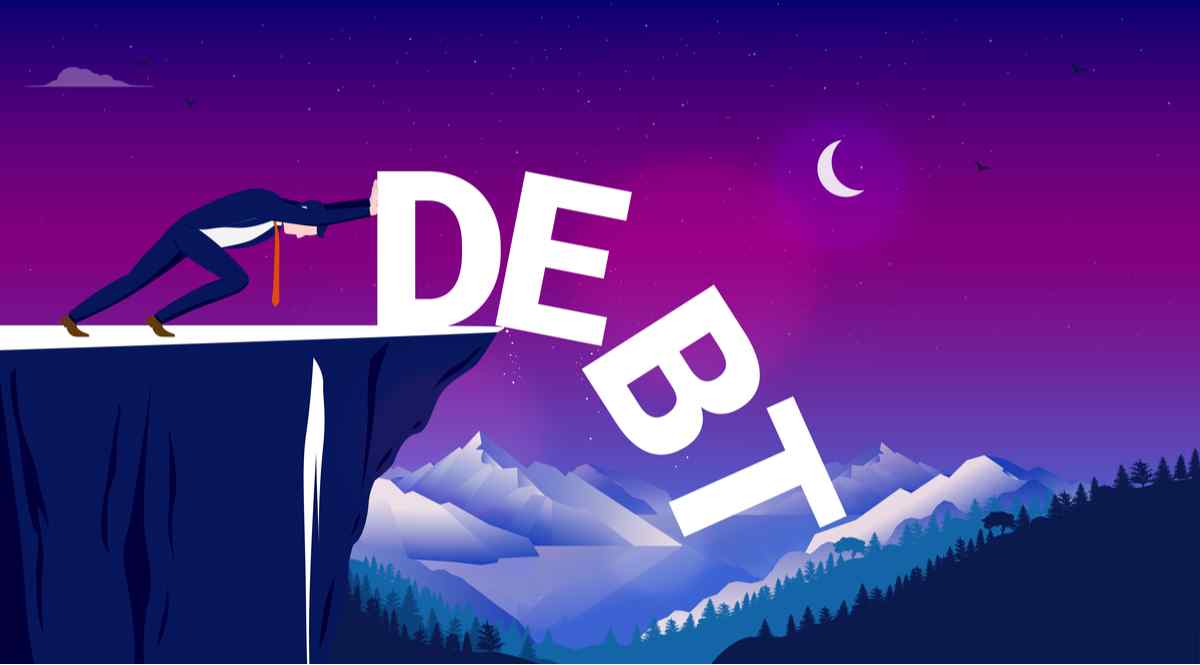What is the Debt Snowball Method?
Is debt inescapable? That perception is true for most, as over 70% of American consumers die in debt. But, it doesn’t have to be that way. There are tricks for paying off your debt sooner. If you have experience building snowballs as a young kid, then you might already know the logic behind one of the best ways to pay back the money you owe. The debt snowball concept is popular among cash-savvy consumers. Let’s find out why.

Popular talk show host Dave Ramsey introduced the five-step Debt Snowball Method to his listeners years ago. With a simple approach, almost anyone can apply this method to relieve debt.
The basic concept is very similar to rolling a snowball. You are probably aware that the easiest and fastest way to get a large ball of snow is to start small with a tight snowball, and then make it bigger via rolling.
The same is true for paying off debt. You pay the smallest amounts of debt first and then roll the rest. Okay, we know it doesn’t make sense right now. We promise that it will.
How to Snowball Debt?
- First, make sure that you budget your expenses and income well enough to cover the minimum monthly payments for each debt that you hold.
- After you do so, it is time for proper arrangement. Organize the debts by balance, from smallest to the largest amount. Don’t worry about the interest rates just yet.
- Once all the ground rules have been set, allocate your available cash toward the smallest debt. Even though this means that you may pay more interest on other loans, it is essential to tackle one at a time. So this means you will be making minimum payments on all your debts but pay extra on the small debt.
- Pay as much as you can on the smallest debt.
- Once the smallest loan has been repaid in full, you can move on toward the next one.
- Keep on following this same method by knocking off smaller debts and moving on to the next biggest debt.
Consider the following representative example. Charlotte needs to pay off four types of credit:
- $10,000 on her car loan
- $3,000 on her credit card
- $1,200 for a laptop she bought on a payment plan
- $600 a short-term loan
According to the Debt Snowball Method, she should make the minimum monthly payment on all four of these bills. (Missing a payment on any of these bills could hurt her credit score, making it harder to find a good loan in the future. Also, missing a bill can result in added fees.) Whatever spendable money she has left after meeting all her other expenses should go toward paying off her $600 short-term loan.
Charlotte will eventually pay off that loan, and then she will only have three types of credit to deal with. That means she has more extra money each month, which she can use to pay off the laptop as fast as possible.
How Does the Debt Snowball Work?
The method works by freeing up more and more cash. In our example above, Charlotte saw the money in her account grow as a result of paying off her smaller loans. That money can go directly toward paying off the bigger debts. Eventually, there is no more debt left, and that extra money can go into savings.
How to Prepare for the Plan?

A good plan only works with preparation and follow-through. Here is what you need to focus on as you start using the method.
● Start By Getting Organized
Staying organized is key to successful debt repayment. The debt snowball method pushes you to organize your credit types from the smallest to the biggest. To do so, one must focus only on balance and exclude the interest rates, monthly payments amount, and other loan terms.
● Keep the Minimum
Just because you are focusing on finishing the smaller loans first, this does not mean to neglect the rest. Make sure you are meeting your minimum monthly payments to avoid fees and penalties.
● Pay Extra
The larger amount of cash that you allocate to a debt, the faster you will be done with it.
● Keep The Routine Going
After you have accomplished your first task to cover the smallest loan, keep it going. Move on to the next smallest debt and make your way to the top.
What is the Avalanche Method?

Another reliable debt repayment plan is known as the debt avalanche method. This is the complete opposite of the debt snowball method, meaning that borrowers are encouraged to tackle their high-interest-rate loans first.
You still make the minimum monthly payments for all the debts you have. However, you pay extra cash for your high-interest rate debts. After finishing off the highest debt, you move on to the second-highest by allocating the minimum payment plus more to complete it.
Think of it this way: Say you have a car loan with 6.8% interest. If you finish off this loan, your budget will no longer suffer the high-interest rate and will earn the equivalent of the interest since you are no longer making any debt payments.
When employing the avalanche method, you will halt compounded interest growth and save cash as you go.
Debt Snowball Calculator

If you are on the lookout for a reliable way to compute your payments, it is advisable to rely on a snowball calculator. Any calculator will do.
All you have to do is add up all the expenses you have to pay off each month. Then, compare that to the money you have coming in. The difference is the money you can use to pay off the smaller debts.
This number helps you set a budget to understand how much extra money you can allocate for each debt per month, more than just the bare minimum. That extra money is the cash you will be utilizing to eliminate your debts.
How to Know if a Debt Snowball is Good for You

Using a debt calculator, you can determine which payment plan your current loan situation. The avalanche method may seem faster and cheaper at first, but a slow and steady approach like the snowball method may cater to your needs better.
If the debt snowball method provides you with the necessary reinforcement to keep you going, it is worth the time and effort to get your financial status back where it belongs.
Debt Snowball vs. Debt Avalanche
One of the two debt repayment methods mentioned in this article may end up working for you. Both are practical methods to approach debt. One may be more efficient in certain situations than the other. The best way to determine that is to compare the two plans.
Repayment
Debt snowball method: You pay off the smallest loans first.
Debt avalanche method: You pay off the largest loans first.
Speed
Debt snowball method: Allows faster elimination of debts, as it tackles the small ones first. In turn, this will give you more motivation to cover the next loan.
Debt avalanche method: Requires more time than the snowball method to cover the first debts, as it will need considerable time to cover the bigger loans. This may affect your motivation, as you will not see any improvements immediately.
Both methods share a similar goal, and that is to help you become debt-free. However, the debt snowball method gives you ample motivation, and motivation is key to success. The small taste of victory when finishing off the first small debt will equip you with a feeling of success and power to tackle your next loan. The debt avalanche method will not give you immediate satisfaction and may discourage you from seeing the plan through. The Avalanche Method may make more sense pragmatically, but motivation is what is going to keep you going.
Debt Management as an Alternative

A debt management program is when credit counselors work closely with lending companies to reduce interest rates and arrange alternative repayment methods. However, debt management programs require monthly fees and can hurt your credit score. This is an informal agreement between borrowers and creditors to pay back non-priority debts. These are basically the non-mortgage debts such as credit cards, installment loans, any other types of loans such as online payday loans, and store cards.
Is a Debt Management Program Right for You?

A debt management program is a good option if any of the following situations apply:
- You are able to afford monthly repayments on your priority debts such as mortgage and your living costs, but struggle to keep up with your other non-priority loans.
- You want another third party expert to deal with your creditors for you.
- Allocating one monthly payment will help you budget better.
You must make sure that you fully understand the impact that a debt management program may have. It may take longer to finish off your debt since you will be paying less than the agreed-upon initial monthly payment. Most creditors may not be so willing to freeze the interest or charges on your debts. While the amount owed per month may decrease, it may not reduce as much as you want. A debt management counselor may charge you a fee for their services. The most significant impact of all is that a debt management program may show up on your credit record, making it harder for you to apply for credit.
Advantages of the Debt Snowball Method

Before jumping into this debt repayment solution, it is smart to look at the pros and cons of the debt snowball.
- The first advantage is the psychological benefit of knocking off one debt at a time from your list.
- This method is particularly suitable for consumers as it helps knock off many debts with outstanding balances and fast. It also helps get rid of the small pesky loans. This allows borrowers to have better financial standing to tackle the more significant and more challenging debts.
- Another advantage of the method is its simplicity. Borrowers do not have to undergo complicated calculations with interest rates and formulas to begin their debt repayment plan. This is an excellent benefit aside from allowing you to take on one debt at a time.
Disadvantages of the Debt Snowball Method
Some of the advantages you see with this method can also end up being bad.
- The snowball method’s most significant disadvantage is that borrowers may not focus on the higher interest charges first. The plan focuses on paying off debts with smaller amounts. This can leave your larger and higher interest debts left for last. For consumers with very high-interest rate loans, the avalanche method may be a more efficient method.
- The snowball method relies on the borrower’s self-guidance and discipline to allocate freed-up cash to pay off smaller debts. Diverging from the set method may result in much more harm than realized.
- Using your spendable income to pay off debts means you will have less money to spend on things you want right now.
If your primary concern is losing out on spendable cash, it may be wise to look closely at your credit card annual percentage rates and loan interest rates. Spending that money wisely now can net you a bigger reward in the long run.
Conclusion
If used properly, this method may provide faster debt relief. But, at the end of the day, the debt snowball technique is just another way to pay off debt. Be sure that this method works best with your current financial status and will not throw your budget off. Conduct the necessary research and calculations to ensure that you will not be paying extra penalties, fees, or interest.





